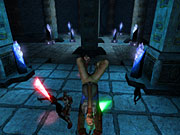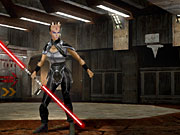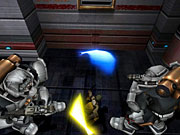Star Wars Jedi Knight: Jedi Academy Designer Diary #3
In our third and final Jedi Academy designer diary, the developers at Raven discuss the game's levels, its balance, and the process of porting the game to the Xbox.
Jedi Knight: Jedi Academy is the follow-up to the acclaimed 2002 action game Jedi Knight II. In previous editions of our designer diaries, we've heard various designers at Raven Software discuss the game's artwork and its characters. In this third and final installment, Raven designers will discuss the game's levels and overall pacing.
Level Design
Ford DyeLevel Designer, Raven Software

I am a new designer at Raven, and I started work in August 2002 on Star Wars Jedi Knight: Jedi Academy. I can't even begin to explain how great it has been to get to know and work with the many great people at Raven. I'm also still not able to really grasp the amazing fact that my first task was to design levels for a Star Wars game! I have been a huge fan of the Star Wars universe since I managed to grow brain cells and gained the ability to use all my senses. Needless to say, I am extremely lucky to be part of such a great company that has had a chance to weave its own stories into the fabric of the Star Wars mythos.
My particular role in the design process was to help plan out a number of the levels in the early meetings and then draw ideas of "flow" and "look" out on paper for approval. Once this stage was completed, we moved quickly into the early "fleshing out" stage of level design to obtain the basic flow and size of each level. The next part of the process allowed us to incorporate some updated Quake III engine technology into our initial detailing passes on the levels. Once the levels had their basic flow, playability, size, lighting, and detail in place, we began to really concentrate on the play and fun of the levels.
From other members of the team, I have seen firsthand the extreme effort to incorporate some of the coolest player creation possibilities, saber moves, and Force powers all into one amazingly fun package. It has been a great learning experience to be able to design environments to house all of these wonderful assets. I was even lucky enough to be able to do design for both the single-player and multiplayer parts of the project.
One of the highlights of the process, for me, was to be able to help incorporate a great deal of new Q3-based technology into the process. The compiling tools and editor were updated significantly, allowing us to really expand what we were able to do in many ways.
On Pacing, Powers, and Porting
Christopher FosterLead Designer, Raven Software
On Star Wars Jedi Knight: Jedi Academy, as well as on Jedi Outcast, I filled the role of lead designer. This made me responsible for making sure all the level and scripting assets were in place for the finished product. Additionally, I oversaw the completion of the multiplayer level assets and portions of the story on both projects. My job involves a lot of scheduling and daily reviews of assets, as well as actual in-game level design work.

Our largest hurdle, from the design side of the process, was in containing the player who has the ability to jump over huge obstacles, run at extraordinary speeds, and deal with enemies in a multitude of ways. Having our experience in Jedi Outcast to fall back on, we planned a system where we could be sure which "troublesome" powers the player would possess at any given time in the game. This allowed us to "key" puzzles and secrets off of these powers and to adequately balance the game with respect to them.
While this allowed us to tighten up the gameplay, involving known power values, we were simultaneously presented with the dilemma of not being able to predict what additional powers the player may have chosen, since this is a new option this time around. We had to play through the areas of the game--with the differing choices--dozens upon dozens of times. We also had to balance the placement of enemies and items carefully to not completely sway the balance toward one specific type of play.
Planning encounters, with the many possibilities of how the player will deal with the enemies, afforded us yet one more challenge: making the areas you fight in allow you to pull off the more-advanced moves and using available weapons without breaking the level. Some areas needed to be reined in to accommodate all the things the player could do, while others needed to be expanded (especially near the end of the game) to allow players to fully explore their new powers. In the end, I believe we stayed true to our original vision of the game while allowing for a variety of creative gameplay options.

As we did with Jedi Knight II, in producing Jedi Knight: Jedi Academy, we focused heavily on planning before we built anything. Some of these areas, as I mentioned above, were changed from their original layout to enhance the gameplay. While sometimes painful, these cuts and reworkings made the final areas of the game much more solid and exciting, and it was my job to make sure they were carried out efficiently. Additionally, some of these changes made porting the game to the Xbox even easier--something we had kept in mind throughout the development cycle of the product.
Our task of completing a worthy sequel that outpaces the original in many respects is nearly complete, and we look forward to sharing the resulting gameplay experience of Jedi Knight: Jedi Academy with the gaming community.
Got a news tip or want to contact us directly? Email news@gamespot.com
Join the conversation